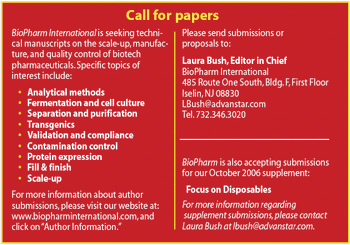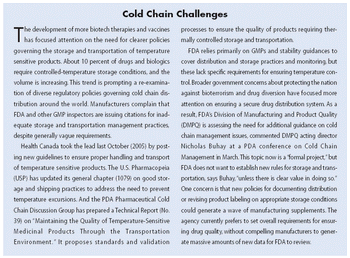
The new legislation authorizes the use of fee revenues for drug safety oversight and assessment throughout a product's lifecycle.

The new legislation authorizes the use of fee revenues for drug safety oversight and assessment throughout a product's lifecycle.

The US Food and Drug Administration's Nanotechnology Task Force (www.fda.gov/nanotechnology/ nano_tf.html) has released a report recommending the agency develop guidelines and take other steps to address the benefits and risks of products, including drugs and medical technology, that use nanotechnology.

The US Food and Drug Administration (FDA, Rockville, MD, www.fda.gov) issued a revised draft guidance on July 20 to help ensure that the safety, purity, and potency of biologics products is not compromised as a result of innovative, flexible manufacturing arrangements.

Any endpoint considered appropriate to support approval, whether a surrogate or a clinical endpoint, must be supported by substantial evidence of effectiveness.

In late June and early July, the US Congress moved forward on three important bills affecting the biopharmaceutical industry, related to follow-on biologics, the Prescription Drug User Fee Act (PDUFA), and the 2008 FDA budget.

The FDA issued MedImmune, Inc. (Gaithersburg, MD, www.medimmune.com), a warning letter for violating the agency's manufacturing rules and held off approving the company's influenza vaccine for use in children younger than age five until the problems are resolved.

The US Food and Drug Administration (FDA, Rockville, MD, www.fda.gov) has issued final recommendations for increasing the supply of safe and effective influenza vaccines for both seasonal and pandemic use.

FDA's approach involves adopting efficient strategies for targeting inspections to more high-risk operations likely to have the greatest impact on public health.

Following the US Senate approval of the FDA Revitalization Act (FDARA, S.1082) in May, the debate over drug safety and the reauthorization of the Prescription Drug User Fee Act (PDUFA) now moves to the House.

Lax enforcement arising from a lack of political will creates the potential for a loss of public confidence.

In March, the US Food and Drug Administration released a new draft guidance, along with its guidance agenda for the year.

Neotropix, Inc. (Malvern, PA, www.neotropix.com), a biotechnology company dedicated to the development and commercialization of virus-based therapeutics for the treatment of cancer and other diseases, received a warning letter (http://www.fda.gov/foi/warning_letters/b6308d.pdf) on March 23, 2007, citing deviations from good laboratory practices (GLP) regulations governing the proper conduct of nonclinical studies as published under 21 CFR Part 58.

The challenge will be to design a system that is flexible, yet appropriate, for the broad range of biological products and the varying quality control capabilities of different manufacturers.

The US Food and Drug Administration (Rockville, MA, www.fda.gov) commemorated its 100th anniversary in 2006 as America's premier public health agency aimed at protecting and promoting public health.

An underlying theme of FDA's drug safety program is that new discoveries in biomedical science can detect risk issues earlier in clinical development.

The pharmaceutical industry is well aware that FDA is trying to take a risk-based approach to enforcing the current good manufacturing practices (cGMP) regulations. This approach is driven by an economic reality: FDA simply does not have the resources to inspect every facility every other year. The organization doesn't even have the resources to inspect facilities every three years. Likewise, it is not cost-effective for our companies to carry out a complete, documentation-oriented revalidation for every process change, regardless of its significance or risk.

In various races in the November elections, voters supported stem cell research. Now, will they prepared to fund it?

A key to bolstering FDA and its mission is securing balanced and consistent funding.

While not yet finalized and adopted, ICH Q10 represents some of the most current thinking with respect to pharmaceuticals manufacturing and control.

Taking a purist stance is always tempting. It can, however, have unintended consequences.

Congress is not considering legislation that would expand FDA authority to regulate biologics.

Food and Drug Administration is encouraging public–private collaborations to more fully explore the physical and chemical characteristics of nanoparticles.

Glavin is preparing a plan to modernize ORA through organizational changes . . .

The Food and Drug Administration recently unveiled its long-awaited Critical Path Opportunities List, which maps out a number of "scientific projects" for improving the testing and production of biotech therapies. In its March report, FDA recognizes that problems in the characterization, testing, and quality management of medical products can delay clinical trials and even completely block drug development.

RFID is currently the most advanced tracking technology, but manufacturers need to pursue a multilayered approach . . .